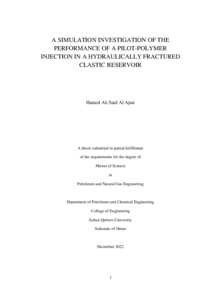Document
A Simulation investigation of the performance of a pilot-polymer injection in a hydraulically fractured clastic reservoir.
Publisher
Sultan Qaboos University.
Gregorian
2022
Language
English
English abstract
In the oil industry, there are many different tertiary EOR methods; however,
polymer flooding is the leading chemical EOR methods used in clastic reservoirs.
Polymers are long-chain molecules composed of many repeated subunits with high
molecular weight. When added to water, they increase the viscosity of the water and
enhance the sweep efficiency, so theoretically more oil would be pushed out and
recovered from the reservoir compared to injecting water solely. This thesis
investigates an ineffective nine-month's pilot-polymer injection test in the HRD
sandstone reservoir (Karim Small Fields' Cluster, Sultanate of Oman). A three dimensional simulator (CMG) has been utilized to create a hydraulic fracturing
model and run a sensitivity analysis, history matching, and optimization for the nine months period. Streamlines simulations have also been performed to verify the
hydraulic fracturing model and the flow directions. The results have given a clear
illustration of the flood behavior and direction within the pattern A-53 for both cases.
The sensitivity analysis has shown that the starting polymer concentration and the
hydraulic fracturing parameters are the most dominating parameters that are
controlling the performance of the polymer injection at the A-field, pattern A-53.
The history-matching exercise has been carried out with the aid of the sensitivity
results to history match the oil rate, water rate, liquid rate, and cumulative oil for the
wells of pattern A-53. Eventually, the Pareto Front Particle Swarm Optimization
technique has been adopted to recommend a feasible polymer injection design that
can be successfully carried out with the maximum possible cumulative oil and Net
Present Value. The concept of polymer slug grading was employed to control the
flood front and prevent the rapid polymer breakthrough caused by the propped
fractures. The study has revealed that the optimized polymer injection would have
increased the NPV by 430k USD; nevertheless, it yielded an insignificant increase in
the cumulative oil.
Member of
Resource URL
Category
Theses and Dissertations

